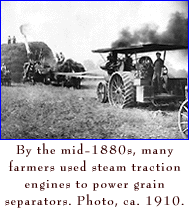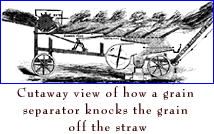Before the Age of Steam, American farmers hand-threshed wheat or oats with a flail. Threshing machines powered by horses or portable steam engines increased daily production of threshing by a hundred times.
Steam-Powered Agriculture
In the 1800s, the large number of horses required for farming consumed a lot of grain. Starting in the 1860s, farmers began threshing grain to feed those horses with a cousin of the "iron horse" - a steam traction engine like the Port Huron Thresher shown above.
As a Michigan farm boy, Henry Ford recorded his first sight of a traction engine: "I remember that engine as though I had seen it only yesterday, for it was the first vehicle other than horse drawn that I had ever seen. It was intended to drive threshing machines and power sawmills and was simply a portable engine and a boiler mounted on wheels." The steam traction engine inspired Ford to design and manufacture automobiles. To other rural people it represented a grand transition in American agriculture, and a new community activity.
 The Firestone Farm, now part of Greenfield Village, was home to Catherine, Benjamin Firestone and their son Harvey, who saw a tremendous amount of change during their lifetime on the farm. As a girl, Catherine, who was born in 1838, probably saw hand-threshing of wheat or oats with a flail. By the time she married Benjamin Firestone in 1863, American farmers had adopted threshing machines powered by horses or portable steam engines. By the time she died in 1916, most farmers participated in a threshing ring, which shared a steam traction engine that traveled from farm to farm and threshed local grain crops. Some farm families organized threshing rings with neighbors; others hired threshing crews to come to their farm. Farm women and girls provided meals for the crew, and men and boys threshed the grain.
The Firestone Farm, now part of Greenfield Village, was home to Catherine, Benjamin Firestone and their son Harvey, who saw a tremendous amount of change during their lifetime on the farm. As a girl, Catherine, who was born in 1838, probably saw hand-threshing of wheat or oats with a flail. By the time she married Benjamin Firestone in 1863, American farmers had adopted threshing machines powered by horses or portable steam engines. By the time she died in 1916, most farmers participated in a threshing ring, which shared a steam traction engine that traveled from farm to farm and threshed local grain crops. Some farm families organized threshing rings with neighbors; others hired threshing crews to come to their farm. Farm women and girls provided meals for the crew, and men and boys threshed the grain.
In 1873, Merritt and Kellog of Battle Creek, Michigan, became the first company to manufacture self-propelled steam traction engines. These engines moved from farm to farm under their own steam. Though some horse-drawn portable steam engines continued in use, the transition to these new engines was under way, and from 1880 to 1930, steam traction engines were a state-of-the-art power source for grain threshing. On larger farms in the Great Plains and West, farmers used horse-drawn or steam-powered combines, but most farmers in the oat and wheat producing sections of the Midwest relied on the steam traction engine and the separator. In the late 1910s and early 1920s, when American tractor companies geared up to transform the American farm with internal combustion tractors, tractor-drawn combines started to replace steam traction engines and grain separators. In less than a hundred years, the nature of grain production in America had changed from intense hand labor to almost total mechanization.
Our Port Huron Engine
| Manufacturer |
|
Port Huron Engine & Thresher Company |
| Date of Manufacture |
|
December 22, 1916 |
| Serial Number |
|
7920 |
| Power off the Draw Bar |
|
19 horsepower |
| Power off the Flywheel |
|
65 horsepower |
| Steam Pressure |
|
175 p.s.i. |
| Fuel |
|
Wood to start operation, coal to operate |
 Joseph Freund of Westphalia, Michigan, purchased the machine in July 1917. He and his partner, Herman Fox, used it to power a Port Huron "Rusher" thresher-separator. How Henry Ford acquired the thresher is unclear, but it may have been purchased for use at one of the Ford farms rather than for the museum. The engine weathered the elements for a number of years outside the Armington & Sims Machine Shop in Greenfield Village. The Historical Operating Machinery specialists of Greenfield Village restored the engine to operating condition in 1981, and it has been maintained ever since.
Joseph Freund of Westphalia, Michigan, purchased the machine in July 1917. He and his partner, Herman Fox, used it to power a Port Huron "Rusher" thresher-separator. How Henry Ford acquired the thresher is unclear, but it may have been purchased for use at one of the Ford farms rather than for the museum. The engine weathered the elements for a number of years outside the Armington & Sims Machine Shop in Greenfield Village. The Historical Operating Machinery specialists of Greenfield Village restored the engine to operating condition in 1981, and it has been maintained ever since.
The Port Huron Engine & Thresher Company began manufacturing threshing machines in Battle Creek, Michigan, as the Upton Manufacturing Company. Its best known product was the "Michigan Sweepstakes" thresher-separator. In 1884, the company relocated to Port Huron, Michigan, and built its first steam engines. In 1890, it became the Port Huron Engine & Thresher Company, and continued manufacturing agricultural steam engines until the 1920s, producing more than 6,000 engines.
See the Port Huron Thresher in Operation During the Fall Harvest Event
The oat and wheat crop from the Firestone Farm is threshed for livestock feed, and the straw saved for bedding. Visit The Henry Ford during the annual Fall Harvest Event in October and watch the Port Huron Engine power a 1932 Nichols & Shepherd "Red River Special," view the Massey-Harris combine in Henry Ford Museum, and visit with the presenters to learn more about America's innovative agricultural history.
Some Other Farm Steam Links
Hanlontown, IA Annual Steam Threshing Days
http://www.heritageparkofnorthiowa.com
Pioneer Steam & Gas Engine Society of Northwestern Pennsylvania, Inc.
http://www.little-mountain.com/pioneer.html
Rock River, Edgerton, WI
http://web2.airmail.net/bealke/thresheree.htm
South Peace Centennial Museum, Alberta, Canada
http://www.spcm.ca